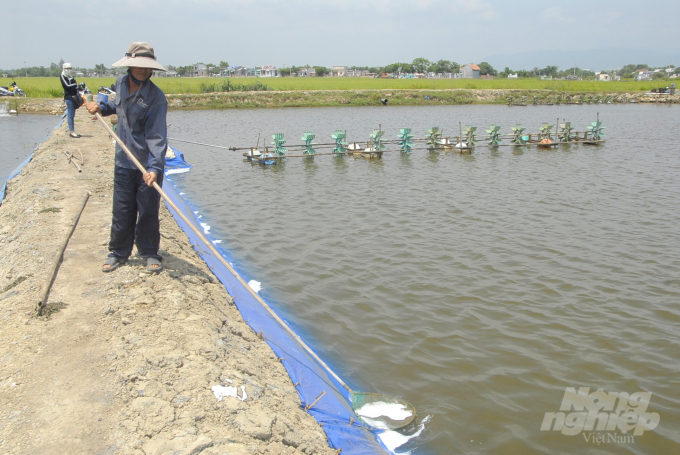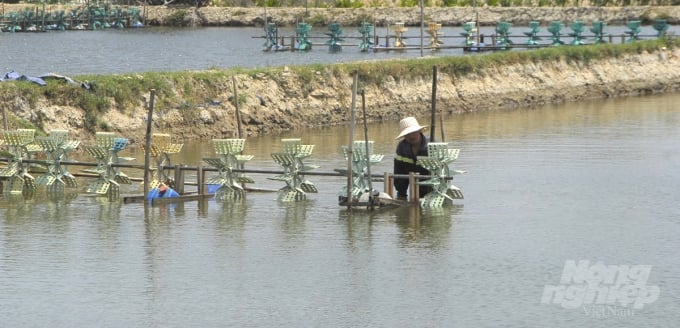November 27, 2025 | 05:30 GMT +7
November 27, 2025 | 05:30 GMT +7
Hotline: 0913.378.918
November 27, 2025 | 05:30 GMT +7
Hotline: 0913.378.918
According to Binh Dinh Fisheries Sub-Department, as of May 2021, the aquaculture area in the whole province is about 3,363ha. In which, the areas of freshwater and brackish water aquaculture are about 1,500ha and 1,863ha respectively.

Shrimp farmers are protecting the aquatic environment in their farming area in Phuoc Thuan Commune, Tuy Phuoc District. Photo: Vu Dinh Thung.
Brackish water shrimp farming area is particularly concentrated in Tuy Phuoc District with more than 958 ha, Phu My district with 439 ha, Phu Cat district with 246 ha, Hoai Nhon town with 132 ha and Quy Nhon city with 87.7 ha. In which, the intensive and semi-intensive farming areas is more than 492ha while those for farming by the improved extensive method is nearly 1,371 ha, accounting for 88% of the total brackish water surface in shrimp farming.
Shrimp farmers in Binh Dinh are currently entering harvest crop 1 but the price of commercial shrimp tends to decrease, only about VND80,000 - 85,000/kg (100 shrimp/kg). Earlier, in the last months of 2020, the price of commercial shrimp in Binh Dinh was up to VND120,000 /kg (100 shrimp/kg). Up to now, only 0.61ha of brackish water shrimp farming area in Binh Dinh has been affected by diseases, accounting for 0.1% of the total farming area, of which, 0.23ha in Phu My district attacked by white spot disease and 0.38ha in Hoai Nhon town suffering from the environmental disease.
According to Mr. Pham Thanh Nhan, Head of Aquaculture Department of Binh Dinh Fisheries Sub-Department, the awareness of protecting the environment in the water area of brackish shrimp farmers in Binh Dinh has been enhanced in the last three years. Thanks to that, diseases on shrimp have been greatly limited.

The aquatic environment in intensive and semi-intensive shrimp farming areas in Binh Dinh is presently stable. Photo: Vu Dinh Thung.
“In addition, a model of community shrimp farming has been built in the province in which, shrimp farming households all adhere to the seasonal schedule, stocking density, and farming methods to improve the aquatic environment. For example, water discharging and absorbing are done simultaneously over the whole area at by the households thus help avoid the spreading of disease in the farming areas,” Mr. Nhan said.
However, according to Mr. Nhan, the water quality in some brackish water shrimp farming areas is low due to pollution. Some households have not complied with the growing density standard as recommended by the authorities and the breed is not guaranteed, so the efficiency is not high. Moreover, infrastructure is weak thus has greatly affected the management and prevention of diseases in the farming area.
“The above situation had resulted in 41.91ha of shrimp farming in Binh Dinh infected with diseases in both two crops of 2020 of which white spot disease attacked 3.63ha, the environmental disease hit 38.28ha, accounting for 2% of the total shrimp farming area, an increase of 1.1% compared to 2019," Mr. Nhan said.
Meanwhile, the VietGAP-oriented shrimp farming model under the Coastal Resources for Sustainable Development (CRSD) project in Cong Luong A village, Hoai My Commune (Hoai Nhon Town) has shown its effectiveness. Diseases were limited and productivity increased.
According to Mr. Ngo Thanh Thoai, an expert from the Economic Office of Hoai Nhon Town, there are 120ha of shrimp farming in the town, concentrating in communes and wards of Hoai My, Hoai Hai, Hoai Huong and Tam Quan Nam. Farmers in Cong Luong A village (Hoai My commune) have dug sedimentation and discharge ponds following the process guided by authorities on 1.8ha among the total 13.5ha of shrimp farming area under the VietGAP standard.

The VietGAP shrimp farming households in Cong Luong A village, Hoai My Commune in Hoai Nhon Town, Binh Dinh Province have raised shrimps in separate settling and rearing and discharging ponds. Photo: Vu Dinh.
Thanks to compliance with the authorized process ensuring a stable aquatic environmental condition, The VietGAP-oriented shrimp farming in Cong Luong A village has limited the infection disease thus increase the shrimp productivity from 10 tons/ha to 12 tons/ha. In other farming areas, the People's Committee of the town assigned the Economic Department and the Department of Natural Resources and Environment to regularly inspect and remind farmers to protect the aquatic environment in accordance with regulations. It also asked the farming households to sign a commitment to protect the environment of aquaculture areas in the province.
Every year, the Provincial Center for Agriculture and Fisheries Promotion built and organize training models and guides shrimp farmers on how to protect the environment in the cultured water area,” said Mr. Thoai.
“The results of environmental monitoring in 2020 showed that, for brackish water farming areas, parameters such as temperature, pH, alkalinity, COD, NO3 an NO2 were within appropriate thresholds; The average salinity fluctuates greatly in the regions of the province. Particularly, the average rate of NH3 and PO4 parameters continued to exceed the allowable threshold. The Sub-Department of Fisheries has advised the Department of Agriculture and Rural Development to develop an environmental monitoring and warning plan in aquaculture for 2021-2025 period to submit to the Provincial People's Committee for consideration and approval”, said Mr. Pham Thanh Nhan, Head of Aquaculture Department, Binh Dinh Fisheries Sub-Department.

(VAN) After the institutional merger, Da Nang possesses significant forest-carbon reserves and is proactively engaging in the carbon market, creating a new revenue stream.

(VAN) An Giang strengthens communication against IUU fishing, increases inspections and sanctions, and is determined to remove the EC’s “yellow card” while developing a sustainable fisheries sector.

(VAN) As green transition becomes a global trajectory, Viet Nam’s biggest challenge is not only technology and models, but how to ensure that capital flows reach the right beneficiaries.

(VAN) The Ministry of Agriculture and Environment must spearhead the construction of green governance, spanning decision-making processes and investment standards to policy evaluation mechanisms.

(VAN) The Agriculture and Environment sector of Khanh Hoa has achieved numerous milestones over the past 80 years, contributing significantly to the goal of establishing the province as a centrally governed city by 2030.

(VAN) Viet Nam is entering the pivotal period of 2025-2030, moving toward the formulation of the Remote Sensing Law, which will establish a legal foundation for the development of national digital data.

(VAN) The agricultural sector is finalizing the strategic framework for emission reduction, setting the goal of sharply cutting methane and 403.7 million tons of CO2 equivalent and moving toward Net Zero by 2050.